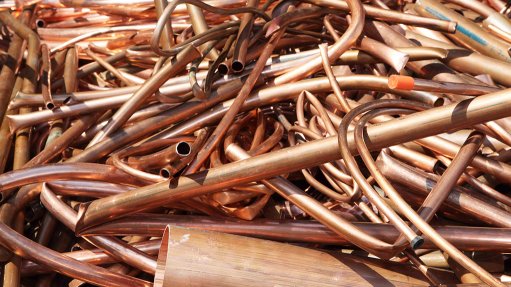
URBAN COPPER MINING Copper is 100% recyclable, without any loss in performance, and can therefore be reintroduced again and again into the material cycle
The high economic value of copper metal is driving the collection and recycling of copper scrap from the downstream value chain as well as from end-of-life products, says European copper industry representative body the European Copper Institute CE John Schonenberger.
He adds that copper is also 100% recyclable, without any loss in performance, and can therefore be reintroduced again and again into the materials cycle.
Schonenberger highlights that recycling prolongs the use of the earth’s natural resources and saves the energy otherwise consumed to process primary raw materials.
He says that copper recycling uses up to 85% less energy than mining production. “At current global recycling rates, this could save up to 85-million TWh of electrical energy, equivalent to the yearly residential electricity consumption of 24-million families, thereby reducing carbon dioxide (CO2) emissions by 30-million tons a year,” Schonenberger enthuses.
He notes that, with society’s demand for smaller products, particularly communications and entertainment devices and systems, which combine multiple building block raw materials, the technologies required to recycle copper and, in particular, copper alloys are becoming more complex.
However, Schonenberger states that this will support new investment and create jobs. The European Union (EU) is the only region of the world where some copper production sites use only recycled feedstock.
Therefore, he says, closing the material loop, by recovering copper and copper alloys from waste, is important for the copper industry, its downstream users and society at large.
“Clearly, the recycling of any material needs to be carried out in compliance with EU and national legislation. “However, given the complexities noted, the challenge for the copper sector is that several other regulatory obligations are diametrically opposed to the goal of increasing recycling rates,” Schonenberger points out.
He highlights that while waste legislation encourages recycling and strives to phase out landfill, other legislation seeks to further reduce industrial emissions into the air, the soil and water.
For example, Schonenberger says that recovering the copper and other metals from complex electronic scrap requires the combustion of the organic fraction. This requires more electricity and generates direct CO2 emissions, both of which are then penalised under the European Unioin Emissions Trading Scheme.
He comments that copper recyclers are also challenged by certain provisions within the EU’s substance legislation, namely the Registration, Evaluation, Authorisation and Restriction of Chemicals and Classification, Labelling and Packaging regulations.
The EU’s technical, scientific and administrative implementation agency, the European Chemicals Agency, and EU member States’ representatives are currently discussing the setting of an extremely strict specific concentration limit for lead metal.
Schonenberger explains that lead has been used, for centuries, in the manufacture of copper alloys and he estimates that there are several million tons of lead-containing copper alloys still in productive use across the EU.
He says that while the copper alloy industry now produces lead-free products, legislators need to agree a solution that allows this “enormous” urban mining resource to be economically reintroduced into a supply chain in ways that are safe for the environment and human health.
“As global demand grows across the world, competition for raw material supplies is understandably increasing and, to safeguard the competitiveness of its recycling facilities, the European copper industry is highly dependent on a steady supply of raw materials.
“The EU and member States need to take further steps to ensure that high-tonnage waste streams, such as electric and electronic waste and end-of-life vehicles, both containing significant amounts of copper, stay in Europe and are recycled in our state-of-the-art installations. The substandard treatment of these waste streams in developing countries is the worst environmental and health option,” Schonenberger concludes.